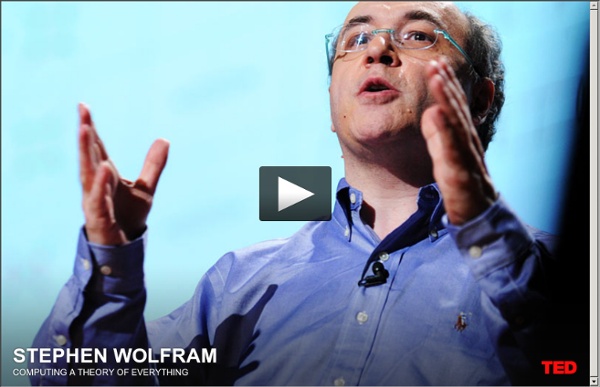



http://www.ted.com/talks/stephen_wolfram_computing_a_theory_of_everything.html
Related: docs mathsWhat does 0^0 (zero raised to the zeroth power) equal? Why do mathematicians and high school teachers disagree Clever student: I know! Now we just plug in x=0, and we see that zero to the zero is one! Cleverer student: No, you’re wrong! You’re not allowed to divide by zero, which you did in the last step. Impress your friends with mental Math tricks « Wild About Math! See Math tricks on video at the Wild About Math! mathcasts page. Being able to perform arithmetic quickly and mentally can greatly boost your self-esteem, especially if you don't consider yourself to be very good at Math. And, getting comfortable with arithmetic might just motivate you to dive deeper into other things mathematical. This article presents nine ideas that will hopefully get you to look at arithmetic as a game, one in which you can see patterns among numbers and pick then apply the right trick to quickly doing the calculation. The tricks in this article all involve multiplication.
Adobe After Effects CS4 * Use Brainstorm to experiment and explore settings Brainstorm creates multiple temporary variants of your composition and displays them in a grid. You can save any number of these variants, apply one to the current composition, or redo the Brainstorm operation using only the variants that you choose as input. Brainstorm uses genetic algorithms to mutate and select property values used as input into each Brainstorm operation. You decide which variants to include as input to each generation and how much mutation (randomness) to use. Aharon Rabinowitz provides a video tutorial on the Creative COW website that demonstrates the use of Brainstorm. View full size graphic
Become Data Literate in 3 Simple Steps Become Data Literate in 3 Simple Steps Just as literacy refers to “the ability to read for knowledge, write coherently and think critically about printed material” data-literacy is the ability to consume for knowledge, produce coherently and think critically about data. Data literacy includes statistical literacy but also understanding how to work with large data sets, how they were produced, how to connect various data sets and how to interpret them. Weierstrass functions Weierstrass functions are famous for being continuous everywhere, but differentiable "nowhere". Here is an example of one: It is not hard to show that this series converges for all x. In fact, it is absolutely convergent. It is also an example of a fourier series, a very important and fun type of series.
Fibonacci in Nature The Fibonacci numbers play a significant role in nature and in art and architecture. We will first use the rectangle to lead us to some interesting applications in these areas. We will construct a set of rectangles using the Fibonacci numbers 1, 1, 2, 3, 5, 8, 13, 21, and 34 which will lead us to a design found in nature. You will need a ruler, protractor, and compass. Watson (computer) Watson is an artificially intelligent computer system capable of answering questions posed in natural language,[2] developed in IBM's DeepQA project by a research team led by principal investigator David Ferrucci. Watson was named after IBM's first CEO and industrialist Thomas J. Watson.[3][4] The computer system was specifically developed to answer questions on the quiz show Jeopardy![5] In 2011, Watson competed on Jeopardy! against former winners Brad Rutter and Ken Jennings.[3][6] Watson received the first place prize of $1 million.[7] Watson had access to 200 million pages of structured and unstructured content consuming four terabytes of disk storage[8] including the full text of Wikipedia,[9] but was not connected to the Internet during the game.[10][11] For each clue, Watson's three most probable responses were displayed on the television screen.
Deep meaning in Ramanujan's 'simple' pattern - physics-math - 27 January 2011 By Jacob Aron The first simple formula has been found for calculating how many ways a number can be created by adding together other numbers, solving a puzzle that captivated the legendary mathematician Srinivasa Ramanujan. The feat has also led to a greater understanding of a cryptic phrase Ramanujan used to describe sequences of so-called partition numbers. A partition of a number is any combination of integers that adds up to that number. For example, 4 = 3+1 = 2+2 = 2+1+1 = 1+1+1+1, so the partition number of 4 is 5.
Prime numbers Version for printing Prime numbers and their properties were first studied extensively by the ancient Greek mathematicians. The mathematicians of Pythagoras's school (500 BC to 300 BC) were interested in numbers for their mystical and numerological properties. They understood the idea of primality and were interested in perfect and amicable numbers. A perfect number is one whose proper divisors sum to the number itself. e.g. The number 6 has proper divisors 1, 2 and 3 and 1 + 2 + 3 = 6, 28 has divisors 1, 2, 4, 7 and 14 and 1 + 2 + 4 + 7 + 14 = 28.